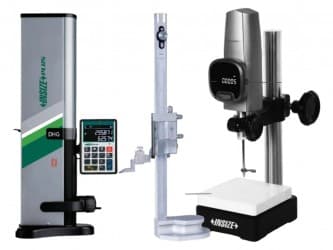Bore Gauges
Bore gauges, also known as bore micrometers or internal
micrometers, are specialized measuring instruments used to measure the diameter
and depth of holes, bores, cylinders, or other internal cylindrical features.
They are commonly used in industries such as machining, manufacturing,
automotive, and aerospace for precision measurements. Bore gauges provide
accurate and reliable measurements of internal dimensions. Here are the key
components and types of bore gauges:
Components of Bore Gauges:
1.
Measuring Head: The measuring head of a bore gauge consists of
two or three contact points or anvils that expand or retract to fit the
internal diameter of the bore being measured. The contact points make direct
contact with the bore surface to provide an accurate measurement.
2.
Measuring Plunger: The measuring plunger is connected to the
measuring head and moves in response to the expansion or retraction of the
contact points. It is typically attached to a spindle that extends outside the
bore and interfaces with the measuring instrument.
3.
Measuring Instrument: Bore gauges are often used in conjunction
with measuring instruments for reading and interpreting the measurements. This
can include dial indicators, digital displays, or micrometer heads.
Types of Bore Gauges:
1.
Two-Point Bore Gauges: Two-point bore gauges, also known as
two-point internal micrometers, have two contact points that expand or retract
to measure the internal diameter of the bore. They are commonly used for
general-purpose measurements and provide reliable and repeatable results.
2.
Three-Point Bore Gauges: Three-point bore gauges, also known as
three-point internal micrometers or three-ball bore gauges, have three equally
spaced contact points that expand or retract to measure the internal diameter
of the bore. The three-point design provides self-centering and ensures
accurate measurements, even in cases where the bore may not be perfectly round.
3.
Pistol Grip Bore Gauges: Pistol grip bore gauges have a
pistol-shaped handle that allows for easy gripping and operation. They often
feature a spring-loaded plunger that automatically expands the contact points
when the handle is squeezed. Pistol grip bore gauges are convenient for
one-handed operation and are commonly used for quick and simple measurements.
4.
Dial Bore Gauges: Dial bore gauges combine a two- or three-point
measuring head with a dial indicator for easy reading and precise measurements.
The dial indicator provides a direct reading of the bore diameter on a
calibrated dial.
5.
Digital Bore Gauges: Digital bore gauges, also known as
electronic bore gauges, feature a digital display that provides a direct
reading of the bore diameter. They are easy to read and offer high accuracy.
Digital bore gauges often have additional features such as data output, memory
storage, and tolerance settings.
Bore gauges are available in various sizes and measuring ranges
to accommodate different bore diameters. They are typically used in conjunction
with a telescopic gauge handle or an extension rod to reach deep or
hard-to-access bores.
Proper care and handling of bore gauges are important to
maintain their accuracy. Regular cleaning, lubrication, and calibration are
necessary to ensure reliable and precise measurements.





